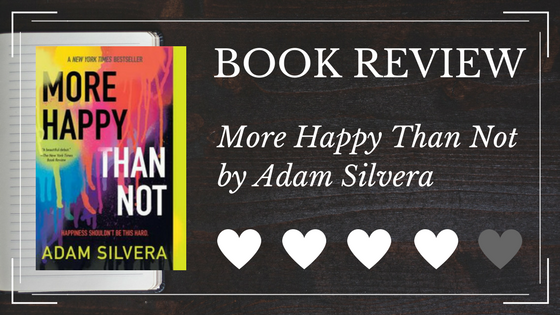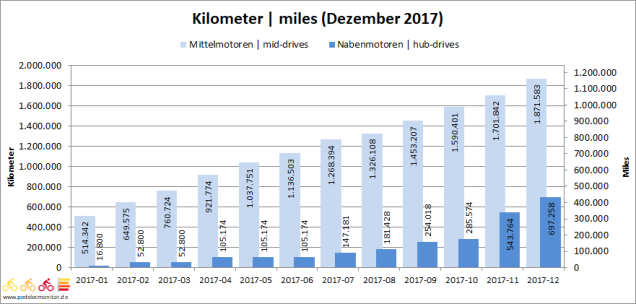One of the first and only things we had decided when we booked our flights was that we would spend New Year’s Eve in Kampala and we had decided to stay at Fat Cat Backpackers, which seemed to be quite popular! The hostel itself is lovely (and was the only place that Jen I and had to share a dorm room with anyone else!) and the facilities were clean and made a nice change. There was a lovely rooftop garden that we spent all three evenings at and was a great place to enjoy a sundowner (well into the early hours of the morning) and to watch New Year’s Eve fireworks. I met some great people at that hostel and it brought to mind some of my favourite memories of making friends in hostels around the world. I even managed to reconnect with an old friend from university who was passing through Kampala for a few hours on her way to South Africa- plenty of time for dinner and drinks and catching up!
 A view from the Fat Cat hostel rooftop
A view from the Fat Cat hostel rooftop
There were quite a few places for food in the vicinity. I would recommend Que Paso (Mexican with some great cocktails) and Mezze (shwarma with a lot of garlic!) nearby, and KURB (a few different street food options and a rooftop bar area) was also great fun. Within a few minutes’ walk of the hostel is Acacia Mall, I walked in and walked out within minutes- it was just too much. I am not entirely sure why it was too much, since we have plenty of malls in Nairobi but I feel like it was a level up if anything. I ended up going clubbing a couple of times (including on New Years Eve) and once you got past all the handsy Ugandans and got them to keep their distance it was great fun! Dancing well into the morning is something I really enjoy, but not something I’ve done in a while- I am glad I remembered, and here’s hoping for more nights like this back in Nairobi in 2018!
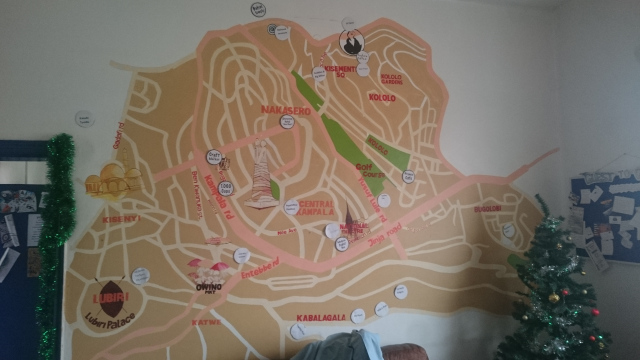 A map of central Kampala on the hostel wall
A map of central Kampala on the hostel wall
It was interesting to note from the very start that the roads in Kampala were much narrower than the Nairobi roads, and with a lot more twists and turns. Even along the tarmac roads, you could see evidence of the red dust of Uganda and there were a lot more trees around! To me atleast, the city appeared friendly. I had been warned about the Kampala traffic, and wasn’t sure what to expect since I know how bad it is in Nairobi. However it wasn’t until we went through Kampala on the way from Jinga to Entebbe that I even had a glimpse of what the traffic could be like! I think roads were still quiet due to the Christmas and NY period, with most people being away in the countryside. That is not to say that Kampala wasn’t chaotic, it most certainly was! It was just quite friendly and approachable about it- if that makes any sense!
One of the first things we did (and I would highly recommend it) was to go up the Kampala Mosque, which is located centrally and the minaret gives great 360 views of the city and the guide was great! We were told about the 7 hills of Kampala, and it was a great way to orient ourselves to the city and to understand how everything was laid out. I took up our map of Kampala, which also helped! I would recommend getting the guide to point out the various bus terminals, to get a rough idea. The mosque is one of the biggest Africa.
We also visited Kabaka’s Palace and had a guided tour (20,000). The palace was built by the 30th King of Buganda, one of the monarchies of Uganda. There are 4 others around the country. Similarly the country is made up of a variety of different ethnicities, most of whom speak a different language (so much so that the language spoken in neighboring towns can be different!). The lingua franca is English and Luganda (which is a Bantu language, similar to Swahili). The languages in the north are niolitic and sound very different! The Bugandan king is only a ceremonial figurehead and advices the Bugandan parliament, which is made up of elders from towns). The Bugandan kings were educated in the UK and this is reflected in the palace architecture. By all accounts they were quite progressive. Until they changed the custom, women weren’t allowed to eat chicken or eggs, since they were only reserved for the men. After visiting Scotland, one of the kings installed two roundabouts on the road between the palace and the parliament with a road through the centre of the roundabout, which only the king could go through. These days, the eldest son of a king becomes the leader of the family and then one of the other sons is chosen to be the king.
During the day on New Years Eve, because it was raining and because it was close to the hostel, we decided to visit the Ugandan National Museum. I am sorry to say it wasn’t great if anything was quite hilarious. As Jen described it, it was like what a teacher would put up in a primary school after a project with unevenly cut, laminated signs and really odd groupings. There was also a bunch of random stuffed animals, in the dark, in the basement. Walking around, it seemed that anyone could pay some money to host an exhibition, among the exhibitions were:
- The dairy industry in Switzerland and Uganda
- The Olympics
- Polish wars
- The controversial dam in Uganda
- Oil exploration in Uganda
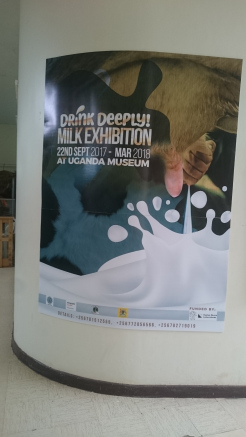
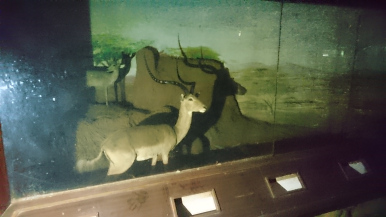
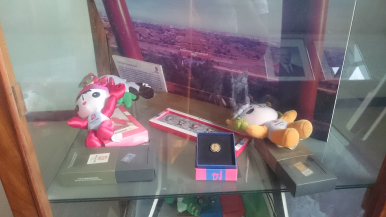
The best bit for me about the museum was the book store, which was right next door and I ended up buying two books. The first a collection of short stories by Ugandan women and the second a collection of stories and poems about Female Genital Mutilation (FGM) in Uganda, Kenya and Ethiopia. FGM has been illegal in Uganda since 2009 although the practice is still continuing in the bush. The book is hoping to educate more people, and especially women about FGM and the impacts of it. It’s a heartbreaking read but I believe it’s really important. The books have both been published by Violet Barungi and FEMRITE and I was more than happy to support such a good cause! We also spent an afternoon at the crafts market (off Buganda Road) and I managed to buy a few gift for my family and a couple of things for myself, which I am pretty happy about. Our lunch at the market was less than a quid and included local food, any carbs such as posho (ugali), rice, matoke (banana), sweet potato, pumpkin etc, and greens in groundnut sauce.
If you want to read about the history of Uganda, there are many good sources but I just wanted to give a whistle stop tour so that you have an idea of the tumultuous half a century that the Ugandan people have had to live through. Uganda gained independence from Britain in 1962, with a promise that the Buganda kingdom would have autonomy. In 1966 Milton Obute, Uganda’s first prime minister orchestrated a coup and ordered his army chief of staff, Idi Amin, to storm the Kabaka’s palace, The Kabaka, i.e. the king, at the time then fled to England where he eventually died. Obute proclaimed himself the president and abolished the Buganda monarchy. Under Obute, the country’s economy went to pots. Then in 1971 when Obute was away in Singapore, Idi Amin staged a coup and named himself the president. Amin, was by all accounts crazy and a reign of terror ensued. Over the 8 years that he was in power, over 300,000 Ugandans lost their live, often quite brutally. As well as targeting the a couple of Ugandan tribes, he also targeted the professional class and finally the Asian community, who were the economic backbone of the country. If you’ve ever watched the Last King of Scotland, it gives you an idea of what he’s like. When we were at the Kabaka’s palace, we went to see Amin’s torture chamber, which was designed to be a weapon storage area. Here prisoners were stuffed into one of the 4 cells, and left to suffocate with no water or food. The only way to get out to the open from the cells was through a trench of water, which was electrocuted. This trench was used to torture the prisoners by turning the electricity of and off.
One of Amin’s few supporters was Colonel Gadaffi, who bailed the Ugandan economy out in the 1970s in the name of Islamic brotherhood (Amin had converted to Islam by then, although previously Israel had supported Uganda by building the airport and even his weapons bunker. Gadaffi even paid for and built the Kampala mosque (finished in 2007), when Amin failed to get it built 1972, which is why the road running up from it is called Gadaffi Road. In 1976, the Palestinians hijacked an Air France plane from Tel Aviv and landed it in Entebbe airport with Amin’s support. The Israel Defence Forces were however able to carry out a mission to free the remaining 94 Israeli passengers (the others had already been released and flown to Paris) since they had designed and built the airport. Amin was then stupid enough to go to war against Tanzania in 1978, and Uganda had a crushing defeat and Amin fled to Libya and Saudi Arabia. Tanzania then installed 2 successive presidents. They were unpopular and Obute returned in 1981 and swept into power (in what’s believed to be a rigged vote). He wasn’t popular for long and was then overthrown in a coup staged by Tiko Okello. Okello, himself didn’t last in power for very long because by the then the National Resistance Army (NRA) under Museveni (the current president – who again is refusing to relinquish power) was at large and in January 1986 they defeated Okello and the army and the war was finally over. Museveni then got on with the job of rebuilding the country peacefully. The 1990s for Uganda was economically prosperous and there was unprecedented growth. There was however the issue of Joseph Kony and the Lords Resistance Army (LRA), the last remaining rebel group, who reigned in terror in Northern Uganda. His vicious tactics included torture and mutilation and the LRA abducted children to become child soldiers and sex slaves (a recent Guardian article about the reintegration of child soldiers). Although the LRA’s campaign ebbed in the 2000s, even as late as 2008 he was still abducting children and many Ugandan’s were too scared to return to their homes in the North (he’s still at large).
Museveni won the 2016 Ugandan elections, again…. His popularity is now decreasing and there is a call to bring in laws for a presidential age limit, which would prevent him from running for power again. There was an actual brawl in the parliament over this in September 2017 (). Also incidentally Paul Kagame (of Rwanda) fought for the NRA when he was living in exile in Uganda and Museveni was a supporter of the RPF (Rwandan People’s Force) and Kagame himself.
Advertisements Share this:
